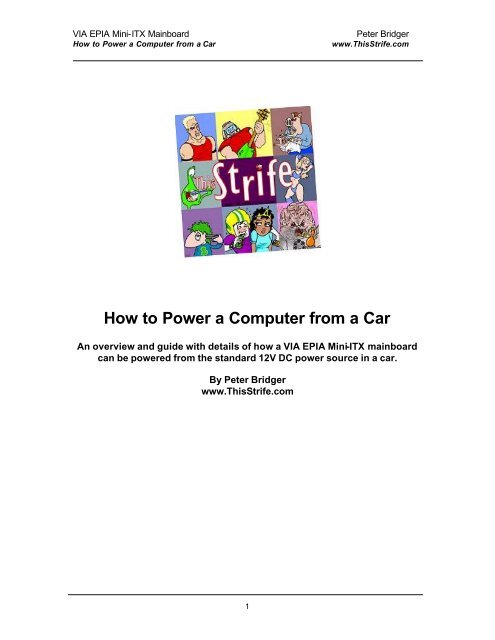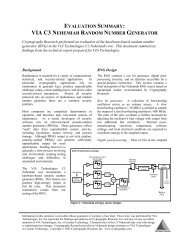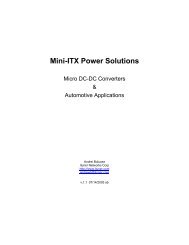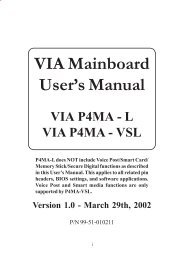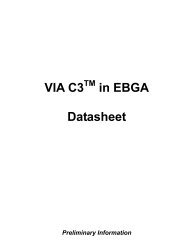You also want an ePaper? Increase the reach of your titles
YUMPU automatically turns print PDFs into web optimized ePapers that Google loves.
VIA EPIA Mini-ITX Mainboard Peter Bridger<br />
<strong>How</strong> <strong>to</strong> <strong>Power</strong> a <strong>Computer</strong> <strong>from</strong> a <strong>Car</strong> www.ThisStrife.com<br />
<strong>How</strong> <strong>to</strong> <strong>Power</strong> a <strong>Computer</strong> <strong>from</strong> a <strong>Car</strong><br />
An overview and guide with details of how a VIA EPIA Mini-ITX mainboard<br />
can be powered <strong>from</strong> the standard 12V DC power source in a car.<br />
By Peter Bridger<br />
www.ThisStrife.com<br />
1
VIA EPIA Mini-ITX Mainboard Peter Bridger<br />
<strong>How</strong> <strong>to</strong> <strong>Power</strong> a <strong>Computer</strong> <strong>from</strong> a <strong>Car</strong> www.ThisStrife.com<br />
Introduction<br />
This guide has been written with the aim of providing an insight in<strong>to</strong> the potential ways of<br />
powering a computer, using a standard 12V car power supply.<br />
I have personally put <strong>to</strong>gether a computer, which is purely designed for being operated and run in<br />
a car. What does this offer? Everything a normal PC can do. It is possible <strong>to</strong> use GPS for<br />
navigation and route planning, <strong>to</strong> watch DVDs and listen <strong>to</strong> MP3s s<strong>to</strong>red on the computer. There<br />
are many possibilities, all you need <strong>to</strong> start with is a solid base. The aim of this article is <strong>to</strong> give<br />
that <strong>to</strong> you, by helping you understand how you may run a computer <strong>from</strong> in your car.<br />
<strong>Car</strong> Battery <strong>to</strong> <strong>Power</strong>ed PC<br />
If you car doesn't need <strong>to</strong> be manually started by a crankshaft, chances are it is fitted with a<br />
standard 12V battery. The battery in your car is not the same as the AA batteries in your TV<br />
remote, or even the types of batteries used in boats and recreational vehicles. Before going<br />
ahead and using the battery for power, it's a good idea <strong>to</strong> understand a bit more about this<br />
device.<br />
<strong>Car</strong> batteries are lead-acid batteries, but have been optimized for their particular purpose. For the<br />
average car user the battery is placed under a similar set of demands. Typically this involves a<br />
large surge of current, which is required <strong>to</strong> start the engine. After the car has started, the<br />
alterna<strong>to</strong>r normally manages <strong>to</strong> keep the spark plugs firing and provide power for the car radio<br />
and other electrical systems. Used in this way it is unlikely that a standard car battery will ever be<br />
drained <strong>to</strong> more than 20% of it's <strong>to</strong>tal capacity.<br />
Due <strong>to</strong> this set of demands, car batteries have been designed <strong>to</strong> give a high current surge of<br />
power <strong>to</strong> start the car. <strong>How</strong>ever, they are not designed <strong>to</strong> be completely drained.<br />
For these reasons it's best <strong>to</strong> not place <strong>to</strong>o high power demands on your vehicles electrical<br />
supply. If you really want <strong>to</strong> use a lot of power, I would recommend using a separate deep cycle<br />
battery. These are designed <strong>to</strong> give a steady output and can be safely discharged.<br />
So now we've got our 12V power supply, how do we run a PC using it? Inside a computer many<br />
different voltages are needed, <strong>from</strong> 12V supplies for the drives <strong>to</strong> a much smaller 2V for the CPU.<br />
What we need is a way <strong>to</strong> convert our 12V input, in<strong>to</strong> the variety of voltages needed <strong>to</strong> power a<br />
PC. There are two ways <strong>to</strong> do this, each with it's own advantages and disadvantages.<br />
DC <strong>to</strong> DC<br />
The first way, and the more efficient way is <strong>to</strong><br />
employ a DC <strong>to</strong> DC converter. The way this device<br />
works is by taking in the 12V power <strong>from</strong> your car,<br />
and then splicing and converting this in<strong>to</strong> the many<br />
different voltages your computer needs. A more<br />
basic way of thinking about it is <strong>to</strong> imagine a<br />
standard ATX power supply, but in this case it<br />
would take in 12V DC rather than the typical<br />
240/120 AC mains voltage.<br />
2
VIA EPIA Mini-ITX Mainboard Peter Bridger<br />
<strong>How</strong> <strong>to</strong> <strong>Power</strong> a <strong>Computer</strong> <strong>from</strong> a <strong>Car</strong> www.ThisStrife.com<br />
As we’re just taking a DC power supply and effectively slicing it up, this is nice and efficient way<br />
<strong>to</strong> power a computer <strong>from</strong> your car.<br />
<strong>How</strong>ever as DC <strong>to</strong> DC converters are quite a niche market, purchasing one can be quite an<br />
expensive experience. Additionally, you must make sure the DC <strong>to</strong> DC converter you bought is<br />
designed <strong>to</strong> take in 12V. For these reasons using a DC <strong>to</strong> DC converter is a more complex<br />
experience than just using an inverter. Although if money is no object, then they are generally the<br />
superior choice.<br />
DC <strong>to</strong> AC <strong>to</strong> DC<br />
The other <strong>to</strong> go about powering the computer uses more<br />
equipment, but it can be cheaper and easier <strong>to</strong> setup.<br />
This method employs one important piece of equipment<br />
called an inverter. This gadget effectively takes in the 12V<br />
DC power <strong>from</strong> your car battery and converts it <strong>to</strong> a<br />
240/120V AC supply. What is the advantage <strong>to</strong> this?<br />
Primarily is gives us a standard power output, just as<br />
you'd find in a domestic power socket. This allows us <strong>to</strong><br />
plug in any household electric item straight in<strong>to</strong> the<br />
inverter. <strong>How</strong>ever there are a few things <strong>to</strong> bear in mind<br />
before connecting your 35" plasma TV <strong>to</strong> your car.<br />
Every inverter has a rated output given in Watts (W), this tells you the maximum amount of watts<br />
it can produce. If you exceed this ceiling, then you'll overload the inverter. This won't result in it<br />
exploding and anything so dramatic, but it will overheat and it's efficiency will drop.<br />
One more thing <strong>to</strong> bear in mind is that some electrical appliances, for example a TV, demands a<br />
surge of power when it's first turned on. This initial surge can place quite a large power demand<br />
on your inverter, which means that such a device won't operate on an inverter if it can't meet it's<br />
initial power demands.<br />
Now we've got our inverter connected in<strong>to</strong> the car, we can move on<strong>to</strong> the next part of system. As<br />
we have a standard domestic power outlet, we can just plug a standard computer PSU straight<br />
in<strong>to</strong> it. This effectively means you could build a computer which would run <strong>from</strong> a household<br />
power socket, then just take it in<strong>to</strong> your car, plug it in<strong>to</strong> your inverter and it would work. This is the<br />
main appeal of using an inverter, the simplify of it's implementation.<br />
When choosing which inverter and PSU <strong>to</strong> use, you must keep in mind the wattage both the<br />
inverter and the PSU produce. If you pair up an 80W inverter with a 300W power supply, you<br />
won't have made a wise choice.<br />
By and large it's best <strong>to</strong> choose an inverter that can produce a bit more power than the PSU. So<br />
connecting a 120W PSU <strong>to</strong> a 150W inverter would be fine.<br />
Remember, the more power you demand <strong>from</strong> the PSU and thus the inverter, the more heat will<br />
be produced and the lower the efficiency will drop.<br />
So <strong>to</strong> sum up, make sure you've got a strong enough PSU <strong>to</strong> operate whatever you plan <strong>to</strong> use<br />
on your computer. Then pair this with an inverter that has a bit of legroom <strong>to</strong> operate with.<br />
3
VIA EPIA Mini-ITX Mainboard Peter Bridger<br />
<strong>How</strong> <strong>to</strong> <strong>Power</strong> a <strong>Computer</strong> <strong>from</strong> a <strong>Car</strong> www.ThisStrife.com<br />
Installing an Inverter<br />
Once you’ve purchased the correct specification<br />
inverter and PSU for your project, the first thing you’ll<br />
want <strong>to</strong> do is plug the inverter in<strong>to</strong> your car cigarette<br />
lighter socket. Virtually all cars are fitted with one, giving<br />
you easy access <strong>to</strong> your cars 12V power supply. If your<br />
car isn’t fitted with a cigarette lighter socket, then you’ll<br />
need <strong>to</strong> buy a kit <strong>to</strong> fit one. These typically consist of a<br />
cigarette lighter socket and a pair of cables that you can<br />
clamp directly on<strong>to</strong> the car battery.<br />
Cigarette lighter sockets normally have a picture of a cigarette on them, <strong>to</strong> indicate their purpose.<br />
Once you have located the socket, remove the cigarette lighter device <strong>from</strong> the socket if one is<br />
plugged in.<br />
Now you can plug in your inverter, by simply<br />
pushing in the input plug in<strong>to</strong> the socket. On some<br />
inverters a LED on the plug will indicate if a circuit<br />
has been made. If your inverter has an LED, but it<br />
is not lit, try turning on your cars ignition.<br />
Some cars have been manufactured <strong>to</strong> keep the<br />
cigarette lighter socket active at all times, but<br />
others need the ignition key <strong>to</strong> active certain<br />
electrical devices.<br />
By now we’ve effectively got a live mains socket <strong>to</strong><br />
use, so the next step is <strong>to</strong> plug in your PSU. This is exactly the same procedure you’d use <strong>to</strong> plug<br />
your PSU in<strong>to</strong> a wall socket, expect in this instance we’re plugging it in<strong>to</strong> the inverter.<br />
4<br />
Now we’re ready <strong>to</strong> plug the main ATX power<br />
connecter <strong>from</strong> the PSU in<strong>to</strong> the motherboard.<br />
Also you can connect up the power cables <strong>to</strong><br />
any drives that need <strong>to</strong> be powered for your<br />
computer <strong>to</strong> operate.<br />
At this stage all the electrical wiring <strong>to</strong> power<br />
your computer is finished.<br />
To test the setup, first make sure everything at<br />
the computer end is wired up. This means have<br />
a keyboard/mouse connected and a moni<strong>to</strong>r.<br />
Turn on your inverter and you’ll most probably hear a slight humming noise <strong>from</strong> the PSU. Finally<br />
you can now turn on your motherboard, if everything is connected <strong>to</strong>gether properly it should whir<br />
in<strong>to</strong> life.
VIA EPIA Mini-ITX Mainboard Peter Bridger<br />
<strong>How</strong> <strong>to</strong> <strong>Power</strong> a <strong>Computer</strong> <strong>from</strong> a <strong>Car</strong> www.ThisStrife.com<br />
If this doesn’t happen, check all the electrical contacts on the cigarette socket, inverter and PSU.<br />
If you still can’t get anything <strong>to</strong> happen, it’s a good idea <strong>to</strong> check the fuses. There’ll most likely be<br />
one in the plug on the power cord that goes <strong>from</strong> the inverter <strong>to</strong> the PSU. Also most inverters<br />
contain a fuse in the cigarette lighter plug. To check this fuse, unscrew the end of the inverter<br />
plug.<br />
Other considerations<br />
By now you should have a computer running <strong>from</strong> your car, however before you drive off in<strong>to</strong> the<br />
sunset, there are a few things <strong>to</strong> bare in mind.<br />
Overheating; bad for the Earth’s icecaps, and equally bad for most electrical equipment. If your<br />
inverter, PSU or CPU overheats, you'll be faced with problems. For this reason it's imperative that<br />
you keep this equipment as cool as possible.<br />
The heat can come <strong>from</strong> two sources, internally or externally. When we're talking about internal<br />
heat, it means a strained inverter overheating <strong>from</strong> having <strong>to</strong> large power demanding input on it or<br />
a CPU with a failed fan, getting <strong>to</strong>o hot.<br />
These instances can be avoided by making sure all your equipment is in good working order, that<br />
the fans are running and that you're not pushing them outside their standard operating ranges.<br />
The other type of over heating, which many people forget about, comes <strong>from</strong> external sources. If<br />
you leave your inverter out in bright daylight, it will rapidly heat up. A black mat finish on such a<br />
device means that it will soak up heat like a sponge. So even if your computer system is running<br />
along perfectly, leaving it out in the sunlight <strong>to</strong> overheat will quickly grind things <strong>to</strong> a halt.<br />
There is one main disadvantage <strong>to</strong> using an inverter, which is that the electrical power it converts<br />
has a different wave pattern than that which a household 240/120V has.<br />
AC stands for Alternating Current, and it does just that. An<br />
AC power supply operating at 50Hz will switch it's polarity<br />
50 times a second. You can see this in the waveform<br />
picture, it results in a wavy pattern. This shows the polarity<br />
of the power changing, giving us a nice clean wavy line.<br />
The image <strong>to</strong> the left demonstrates this type of waveform.<br />
DC means Direct Current, which means no switching<br />
of polarity, just a nice clean steady power supply. So<br />
the inverter must take this DC power and turn it in<strong>to</strong> an<br />
alternating current, just like in a household power<br />
supply.<br />
The trouble is this is more difficult than you might think,<br />
so what most inverters do is produce a modified<br />
sine wave output. Which does alternate like a typical<br />
AC supply, but just not as cleanly. To the right you can see how a modified sine wave looks.<br />
You can buy inverters that do a better job of creating a cleaner AC output, but these devices are<br />
5
VIA EPIA Mini-ITX Mainboard Peter Bridger<br />
<strong>How</strong> <strong>to</strong> <strong>Power</strong> a <strong>Computer</strong> <strong>from</strong> a <strong>Car</strong> www.ThisStrife.com<br />
a fair bit more expensive than inverters that employ a modified sine wave output.<br />
Why is this a problem? Generally speaking it's not, and most equipment doesn't mind using the<br />
modified sin wave output that most inverters produce. But even though a device may work on a<br />
modified sine wave, it is likely <strong>to</strong> produce a humming noise.<br />
The only way <strong>to</strong> get around this, without buying a more expensive inverter, is by applying sound<br />
insulation. This can have the downside of also insulating heat, giving you a quiet, but hot PSU. So<br />
this may be an area you may want <strong>to</strong> experiment in, depending on how distracting you find this<br />
problem. Personally I find the engine noise <strong>to</strong> be much more of a distraction, than a slight<br />
humming.<br />
Where <strong>to</strong> Buy Equipment<br />
The following equipment list is only supplied as a guideline or suggestion as <strong>to</strong> where you can<br />
find these items. I do not endorse any of the following companies or they products. If you find a<br />
device elsewhere that meets all your criteria, then invest in that one instead.<br />
Inverters<br />
Remember when buying an inverter make sure it is compatible with your PSU. As each country in<br />
the world has it’s own particular domestic power standards.<br />
http://www.electronixwarehouse.com/car/accessories/power-inverters.htm<br />
http://www.maes.ltd.uk/<strong>Power</strong>_Inverter.php<br />
http://www.majorpower.com/inverters/<br />
http://www.mdsbattery.co.uk/departments/Department003.asp?DepartmentID=113<br />
DC <strong>to</strong> DC converters<br />
These devices are a little more tricky <strong>to</strong> find, I suggest you do you own research here.<br />
http://www.emca.co.uk/bps-7004.htm<br />
http://www.procase.com.tw/2677.htm<br />
PSU<br />
If you’re running a computer in your car, hopefully you’ve designed it <strong>to</strong> be low powered. So you’ll<br />
need <strong>to</strong> get a low power PSU unit. A 120W PSU is a good bet, Flex-ATX ones can easily be<br />
found at this rating.<br />
http://www.insight.com/<br />
http://www.dabs.com/<br />
http://www.seasonic.com/products/p_all.htm#<br />
6
VIA EPIA Mini-ITX Mainboard Peter Bridger<br />
<strong>How</strong> <strong>to</strong> <strong>Power</strong> a <strong>Computer</strong> <strong>from</strong> a <strong>Car</strong> www.ThisStrife.com<br />
Finally<br />
Remember powering your car system is about building a solid foundation with which <strong>to</strong> create<br />
your ideal car computer, whatever this may be. It doesn't matter how flashy and advanced the<br />
computer is, if your power supply keeps cutting out.<br />
Most of the time it's worth paying out a little extra <strong>to</strong> get a name you trust or something that is<br />
covered by a warranty. By the same thread, it's always worth looking around <strong>to</strong> see if you can find<br />
the same product cheaper being sold elsewhere. I've seen the same inverters varying in price by<br />
as much as 50% of the price of the cheapest.<br />
<strong>How</strong>ever you wish <strong>to</strong> tackle this part of your car system, I wish you the best of luck and hope you<br />
enjoy working <strong>to</strong> create your own system.<br />
Peter Bridger<br />
peter.bridger@thisstrife.com<br />
www.thisstrife.com<br />
7


